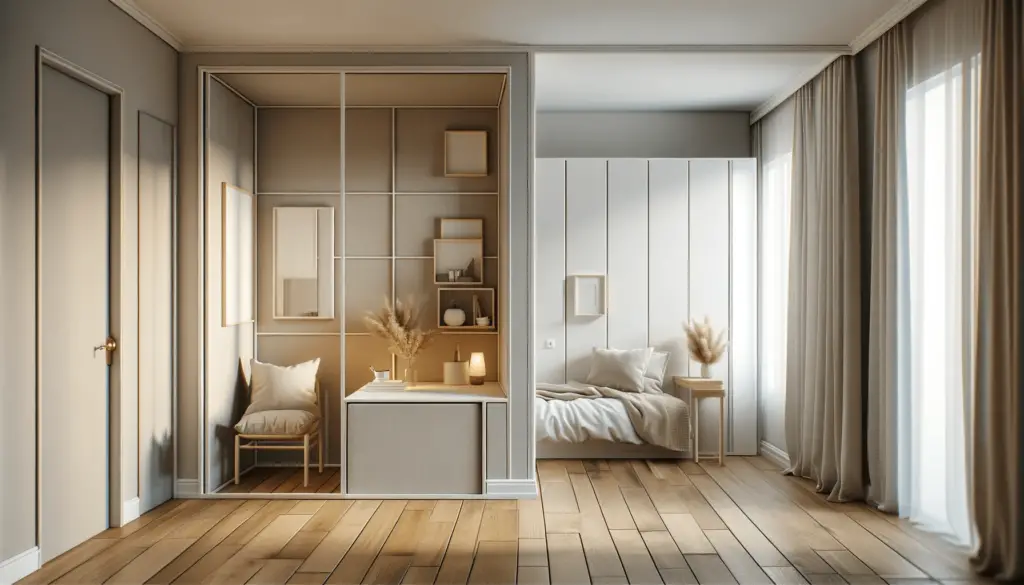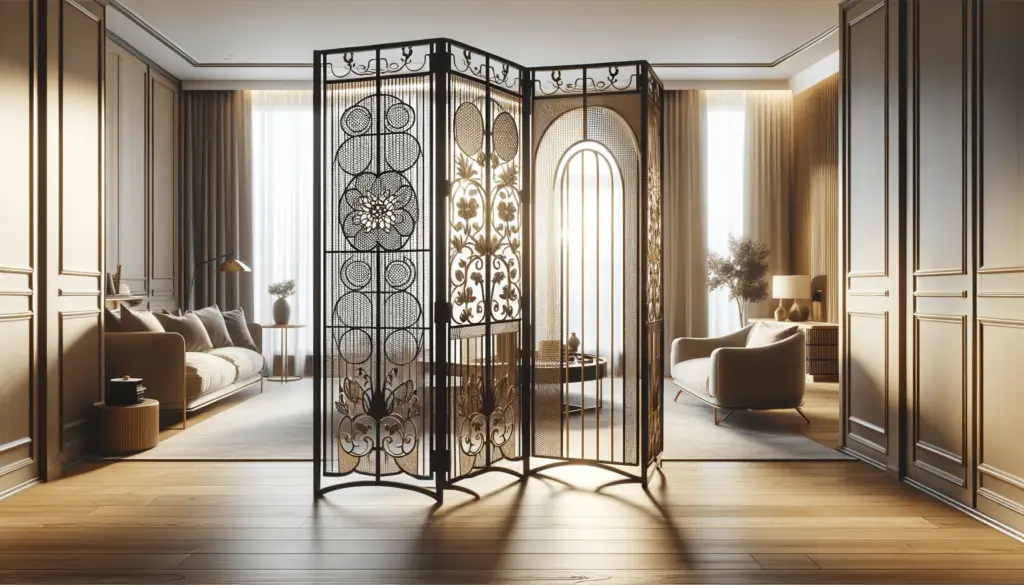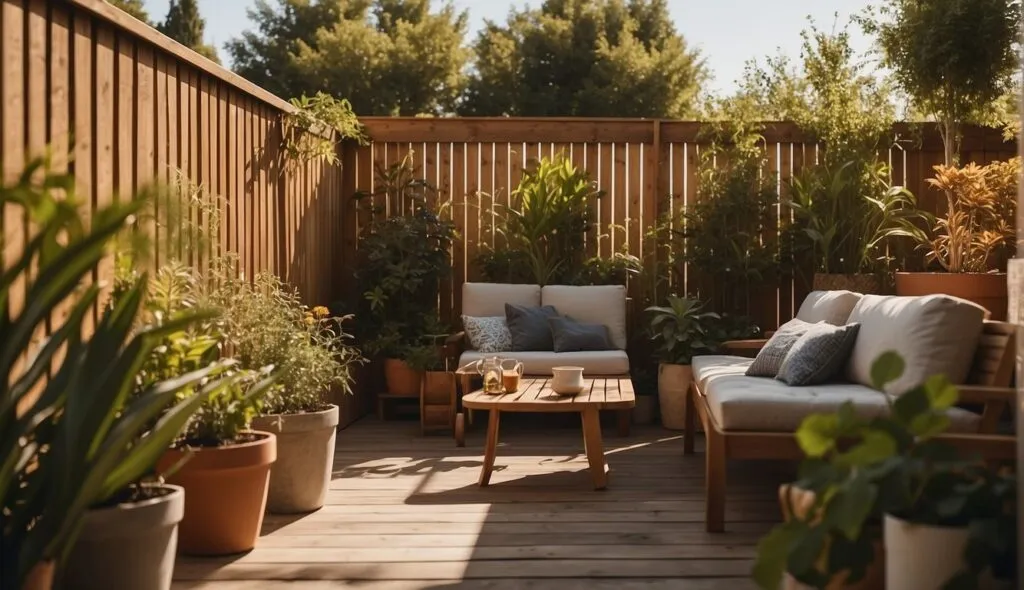Small spaces can be challenging to decorate and furnish, especially when it comes to creating privacy. Whether you have a small balcony, patio, or backyard, finding the right privacy screen solution can be a game-changer. In this article, we’ll explore some innovative solutions for small space screen solutions, from designing for privacy to choosing the right privacy screen and installation tips and tricks.

Understanding Small Space Screen Solutions is crucial to creating a private and comfortable outdoor space. With more people living in urban areas, small patios, balconies, and backyards are becoming increasingly common. Privacy screens can help create a sense of seclusion and intimacy in these small spaces. However, choosing the right privacy screen can be daunting, with so many options available in the market. In this article, we’ll help you navigate through the different types of privacy screens available and choose the right one for your small space.
Table of Contents
Key Takeaways
- Small spaces can be challenging to decorate and furnish, especially when it comes to creating privacy.
- Understanding Small Space Screen Solutions is crucial to creating a private and comfortable outdoor space.
- Choosing the right privacy screen can be daunting, with so many options available in the market.
Understanding Small Space Screen Solutions
Small space screen solutions are a great way to maximize the functionality of a small space. They come in various sizes and types, and can be customized to fit a home’s unique layout. In this section, we will take a closer look at the different types of screens available and the benefits of privacy screens.
Types of Screens
There are several types of screens available for small space solutions. One of the most popular types is the retractable screen. Retractable screens are great for small spaces because they can be easily hidden away when not in use. They are also available in different sizes and can be customized to fit any space.
Another type of screen that is popular for small spaces is the sliding screen. Sliding screens are great for areas that require more privacy, such as bedrooms or bathrooms. They are also available in different sizes and can be customized to fit any space.
Benefits of Privacy Screens
Privacy screens are a great addition to any small space. They offer several benefits, including privacy, light control, and energy efficiency. Privacy screens are great for areas that require more privacy, such as bedrooms or bathrooms. They can also be used to control the amount of light that enters a room, which can help save on energy costs.
In addition to their practical benefits, privacy screens can also add style to a small space. They come in a variety of colors and styles, so they can be customized to fit any decor. Whether you prefer a modern or traditional look, there is a privacy screen that will fit your style.
Overall, small space screen solutions are a great way to maximize the functionality of a small space. Whether you choose a retractable screen or a sliding screen, or opt for a privacy screen, you can be sure that you are making the most of your space.
Designing for Privacy in Small Patios
When it comes to small patios, privacy can be a challenge. However, with the right design choices, you can create a comfortable and private outdoor space. In this section, we will discuss some material selection and creative layout ideas to help you design for privacy in small patios.
Material Selection
The materials you choose for your small patio can greatly impact the level of privacy you can achieve. Some materials that can help create privacy include:
- Trellises and Screens: Adding a trellis or screen to your patio can create a natural barrier between you and your neighbors. You can choose from a variety of materials, including wood, metal, and vinyl, to match your patio’s style.
- Plants: Incorporating plants into your patio can help create a natural barrier. Consider using tall plants, such as bamboo or tall grasses, to block the view from neighboring properties.
- Fencing: Installing a fence around your patio can help create a private space. You can choose from a variety of materials, such as wood or vinyl, to match your patio’s style.
Creative Layouts
In addition to material selection, the layout of your patio can also impact privacy. Here are some creative layout ideas to help you design for privacy in small patios:
- L-Shaped Layout: An L-shaped layout can create a private corner in your patio. You can use a trellis or screen to create a natural barrier between the corner and the rest of the patio.
- U-Shaped Layout: A U-shaped layout can create a private space in the center of your patio. You can use a trellis or screen to create a natural barrier between the center and the rest of the patio.
- Built-In Seating: Incorporating built-in seating into your patio can help create a private space. You can use a trellis or screen to create a natural barrier between the seating area and the rest of the patio.
By selecting the right materials and layout, you can create a private and comfortable outdoor space in your small patio.
Maximizing Small Backyard Privacy
When it comes to small backyard privacy ideas, there are a few things we can do to maximize the space we have. Whether you’re looking to create a cozy outdoor oasis or just want to block out the neighbors, we’ve got you covered. Here are a few small backyard ideas privacy that we recommend:
Strategic Planting
One of the easiest and most effective ways to create privacy in a small backyard is through strategic planting. By planting trees, shrubs, and other greenery in strategic locations, we can create a natural barrier that blocks out unwanted views and noise. Some of the best plants for this purpose include bamboo, arborvitae, and evergreens. These plants are dense, fast-growing, and require little maintenance, making them ideal for small spaces.
Fencing and Paneling
If you’re looking for a more permanent solution, fencing and paneling are great options. Not only do they provide privacy, but they can also add style and visual interest to your backyard. When choosing a fence or panel, consider the style of your home and the overall aesthetic you’re going for. Some popular options include wood, vinyl, and metal. For a more modern look, consider using slatted panels or a combination of materials.
In conclusion, there are plenty of small space screen solutions that can help maximize privacy in your backyard. Whether you choose to use plants or panels, the key is to be strategic and think outside the box. With a little creativity and planning, you can create a private outdoor space that feels like an extension of your home.
Innovative Solutions for Small Yard Privacy
If you have a small yard, you may think that privacy is impossible to achieve. However, there are many innovative solutions that can help you create a private oasis in even the smallest of spaces. In this section, we will explore some of the best small yard privacy ideas that are both functional and stylish.
Multi-Functional Pieces
One of the best ways to maximize space in a small yard is to use multi-functional pieces. For example, a bench with built-in storage can provide seating and also serve as a place to store outdoor cushions and other items. Another option is to use a privacy screen that doubles as a planter. This allows you to create a natural barrier while also adding greenery to your space.
Vertical Privacy Options
When you don’t have a lot of horizontal space, it’s time to start thinking vertically. There are many options for vertical privacy screens that can help you create a private space without taking up too much room. For example, you can use a trellis to grow climbing plants that will create a natural barrier. Another option is to use a hanging garden that can be attached to a wall or fence. This allows you to add greenery while also creating a private space.
In conclusion, there are many innovative solutions for small yard privacy that can help you create a private oasis in even the smallest of spaces. By using multi-functional pieces and vertical privacy options, you can maximize your space while also creating a stylish and functional outdoor area.
Choosing the Right Privacy Screens
When it comes to small space screen solutions, privacy screens are an excellent option to consider. They not only provide privacy but also help reduce glare and protect your screen from scratches and damage. However, choosing the right privacy screen can be a daunting task. Here are some factors to consider when selecting a privacy screen for your small space:
Size and Portability
Privacy screens come in various sizes, and it’s essential to choose one that fits your device’s screen. You don’t want a privacy screen that’s too big or too small, as it won’t provide the necessary protection. Additionally, if you plan to use your device on the go, consider a privacy screen that’s lightweight and easy to carry. Some privacy screens come with a carrying case, making them convenient to transport.
Aesthetic Considerations
Privacy screens come in different colors and styles, so you can choose one that complements your small space’s decor. Some privacy screens have a matte finish that reduces glare, while others have a glossy finish that enhances the image’s clarity. Additionally, some privacy screens have a frameless design, making them less obtrusive and more aesthetically pleasing.
When choosing a privacy screen for your small space, consider the size and portability, as well as the aesthetic considerations. With the right privacy screen, you can enjoy the benefits of privacy and screen protection without sacrificing style or convenience.
Installation Tips and Tricks

When it comes to installing screens in small spaces, there are a few tips and tricks that can make the process easier and more efficient. We’ve compiled some of our favorite tips below to help you get started.
DIY Installation
If you’re planning on installing screens yourself, there are a few things you should keep in mind. First, make sure you have all the necessary tools and materials before you begin. This may include a spline roller, screen fabric, spline, and a utility knife.
Before you start installing screens, it’s also important to measure the area where you’ll be installing them. This will ensure that you purchase the right amount of screen fabric and spline.
Once you’re ready to start installing screens, begin by removing the old screens and cleaning the frames. Then, lay the screen fabric over the frame and use a spline roller to press the spline into the groove around the frame. Trim off any excess screen fabric with a utility knife.
Professional Installation
If you’re not comfortable installing screens yourself, you may want to consider hiring a professional. Professional installers have the experience and expertise needed to ensure that screens are installed correctly and efficiently.
When choosing a professional installer, make sure to do your research and choose someone who has experience working with small spaces. You may also want to ask for references and read reviews before making a final decision.
Overall, whether you choose to install screens yourself or hire a professional, it’s important to take your time and ensure that screens are installed correctly. With the right tools and techniques, you can create a comfortable and functional small space that you’ll love spending time in.
Maintenance and Care of Privacy Screens

At Silentia Screen System, we understand that maintaining and caring for privacy screens is essential for ensuring a hygienic and safe environment in healthcare settings. Here are some tips on how to keep privacy screens clean and in good condition.
Cleaning Methods
To clean privacy screens, we recommend using a disinfectant solution and a soft cloth. Avoid using abrasive materials or harsh chemicals that can damage the screen’s surface. Wipe the screens down regularly to prevent the buildup of dirt and bacteria.
For stubborn stains, we suggest using a non-abrasive cleaner and a soft-bristled brush. Be sure to rinse the screens thoroughly with water after cleaning and dry them with a clean cloth to prevent water spots.
Durability and Longevity
At Silentia, we design our privacy screens with durability and longevity in mind. Our screens are made from high-quality materials that are resistant to wear and tear, making them ideal for high-traffic areas.
To ensure the longevity of your privacy screens, we recommend inspecting them regularly for signs of damage. If you notice any cracks, scratches, or other damage, contact us immediately for repair or replacement.
In conclusion, proper maintenance and care of privacy screens are essential for ensuring a hygienic and safe environment in healthcare settings. By following these tips, you can keep your privacy screens clean and in good condition for years to come.
Legal Considerations and Neighborly Etiquette

When it comes to small space screen solutions, it’s important to keep in mind the legal considerations and neighborly etiquette. Here, we’ll provide some guidelines to help you navigate the process.
Understanding Regulations
Before installing any type of screen, it’s important to understand the regulations in your area. Check with your local government to find out if there are any restrictions on the height or placement of screens. In some cases, you may need to obtain a permit before installing a screen.
It’s also important to consider any homeowners’ association (HOA) rules that may apply. Some HOAs have strict guidelines regarding the appearance of outdoor structures, including screens. Make sure you understand these rules before installing a screen to avoid any potential conflicts.
Communicating with Neighbors
Installing a screen can impact your neighbors’ views and privacy, so it’s important to communicate with them before making any changes. Let them know your plans and ask for their input. Be open to their concerns and try to find a solution that works for everyone.
Consider the placement of the screen carefully. If it will block your neighbor’s view, try to find a solution that maintains their privacy while still meeting your needs. You may also want to consider the aesthetics of the screen to ensure it blends in with the surrounding environment.
In addition to communicating with your immediate neighbors, it’s also a good idea to inform anyone who may be impacted by the screen. For example, if you live in a multi-unit building, let your landlord or property manager know about your plans.
By following these guidelines, you can install a small space screen solution while also being a considerate and responsible neighbor.
Conclusion

In conclusion, small space screen solutions are essential for maximizing functionality and productivity in compact living environments. By using delayed response and semi-transparency of control objects, we can efficiently use small screen space. Additionally, smart design choices such as using multi-functional furniture and utilizing vertical space can make a significant difference in small spaces.
Workspace solutions for small spaces are also crucial in ensuring that we remain productive and comfortable. Desks with adjustable heights, storage solutions, and ergonomic chairs are just a few examples of workspace solutions that can improve our overall work experience.
Moreover, it is essential to plan and consider the lighting in small spaces. Natural light is the best option, but if it is not available, we can use artificial lighting to create the illusion of natural light.
In summary, small space screen solutions, workspace solutions, and lighting are essential factors to consider when designing and living in small spaces. By implementing these solutions, we can create functional, comfortable, and inviting spaces that maximize the potential of small living environments.
Frequently Asked Questions

What are some effective temporary room divider options?
When it comes to temporary room divider options, there are several choices to consider. One of the most popular and affordable options is a tension rod divider. This type of divider is easy to install and can be adjusted to fit a variety of room sizes. Another option is a folding screen, which can be moved around as needed and comes in a variety of styles to fit any decor.
How can I create a floor-to-ceiling room divider in a small space?
Creating a floor-to-ceiling room divider in a small space can be challenging, but it is possible. One option is to use a bookcase or shelving unit as a divider. This not only provides separation between the two areas but also adds storage space. Another option is to install a sliding door or a hanging curtain that can be pulled closed when privacy is needed.
What are innovative ways to use hanging room dividers in a studio apartment?
Hanging room dividers are a great way to create separate areas in a studio apartment without taking up valuable floor space. One innovative way to use hanging dividers is to create a vertical garden or a hanging plant wall. This not only provides separation between the living and sleeping areas but also adds a beautiful and natural element to the space.
Can you suggest modern wall partition ideas for a small living area?
Modern wall partition ideas for a small living area include using a glass partition, which allows light to flow through and creates the illusion of a larger space. Another option is to use a decorative folding screen that can be easily moved around as needed. Alternatively, a bookcase or shelving unit can be used as a partition and also provides storage space.
What types of furniture work best as room dividers in a compact bedroom?
In a compact bedroom, furniture that doubles as a room divider is a great option. A bookshelf or a storage unit with open shelves can be used to divide the space and also provides storage space for clothing and other items. Another option is a folding screen or a hanging curtain that can be easily moved around as needed.
What are cost-effective methods to divide one room into two functional areas?
There are several cost-effective methods to divide one room into two functional areas. One option is to use a large area rug to define the different areas. Another option is to use a folding screen or a bookcase as a divider. Alternatively, a hanging curtain or a sliding door can be installed to create separate areas.



Pingback: Space Saving Privacy Ideas for Small Homes - ecolivingjourney.com